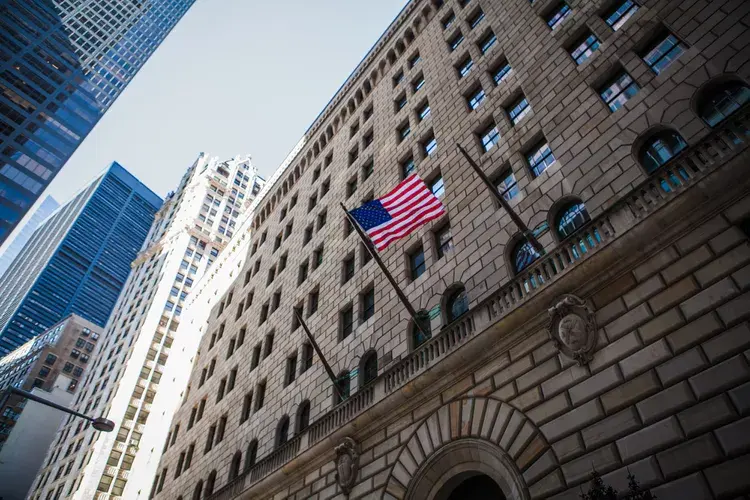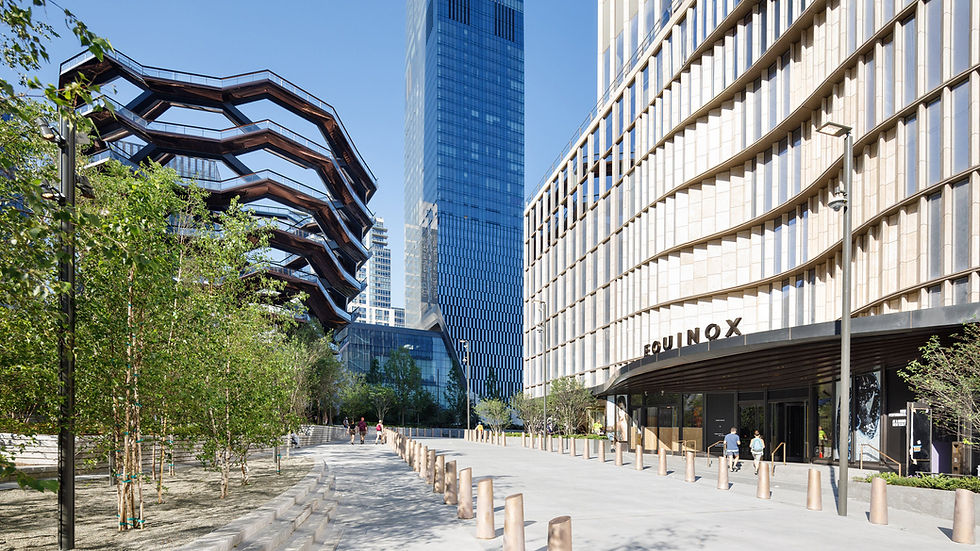Weekly Market Report - September 23, 2022
- Norman Bobrow

- Sep 23, 2022
- 6 min read
***
Lots of people always hated the “open” office layout designed to foster collaboration. There’s nowhere to hang your stuff, nowhere to have a sensitive conversation and nowhere to focus without overhearing colleagues’ blabbering. Plus, several studies indicate that the supposed benefits of togetherness and transparency are overrated. The privacy many got used to while working from home only intensified the loathing—as did the “hot” desk system businesses adopted for hybrid employees to drop into reopened office buildings. You didn’t have enough personal space before? Let’s try taking away your assigned seat. Though the experiment continues in some quarters, a number of firms are going in the other direction, according to property managers and designers, erecting new partitions to give employees some separation from one another.
“Seated privacy” is the latest buzzy term in office design, says Kristi Buchler, principal at Interior Architects, which helps companies plan workspaces. Many new cubicles in formerly open setups feature low walls topped with glass, giving workers a sense of solitude when in their chairs, she says. “But I can still pop my head up and easily go, ‘Oh, my colleague just got here. Great! I had a question for them.’ Ms. Buchler adds that more executives are asking for two workstations for themselves: one that’s exposed and accessible by rank-and-file employees and another that’s secluded for small meetings or calls. The goal in many new designs, she says, is to achieve a mix of collaborative and quiet zones.
Openness was often an illusion, she explains, because a lack of dividers between workers belied the reality that each had as little as 3 horizontal feet at a shared table. It was barely enough for a laptop and a latte from the coffee bar that (along with the ping pong and foosball tables) took up precious floor space.
***
Office use on average was 47.5% of early 2020 levels for workers in the office over the five business days from Sept. 8 to Sept. 14 in the 10 major metro areas monitored by Kastle Systems. The company, which tracks security swipes into buildings, said that was the highest percentage since late-March 2020. Midweek days were especially strong, with office use for Tuesday and Wednesday last week at about 55% of the pre-pandemic workforce, also a high during the pandemic for those days. Other indicators show a return-to-office pickup after Labor Day.
On Wednesday, ridership on the Long Island Rail Road surpassed 200,000 for the first time since March 2020. Metro-North Railroad, another commuter line in the New York region, also reached a high for the pandemic period on Wednesday with 174,900 riders. Most employees are returning as part of hybrid workplace strategies that allow them to split time between the office and remote work, though even here employees have experienced a recent shift toward the workplace. Some businesses are moving toward requiring three days of in-office attendance, up from two days. Some companies also are facing pushback from employees who don’t like the new strategies.
***
Private equity shop Blue Owl Capital Inc. is expanding its offices in Manhattan with a lease at Park Avenue’s landmark Seagram Building. The Manhattan-based firm, with more than $119 billion in assets under management, is taking 137,660 square feet of space in the tower at 375 Park Ave. Its landlord, Aby Rosen’s RFR Holding LLC, has signed a total of 375,000 square feet of leases this year at the 38-story building with tenants including Clayton, Dubilier & Rice, Sound Point Capital Management and Teachers Insurance and Annuity Association of America, which plans to use the space for Churchill Asset Management.
Finance firms have been vocal about the need for employees to get back to the office, after more than two years of widespread remote work. Companies from Citadel to Blackstone have been on the hunt for space and are gravitating toward new or renovated skyscrapers full of amenities to attract talent. Related Cos. and Brookfield Properties have recently lured banks and law firms to relocate their offices to new developments on the far west side of Manhattan.
***
Unsteady markets make for safe investments, so hearing that the state of the refinance market resembles a kaleidoscope isn’t too reassuring. The environment for commercial refinancing, especially for less desirable office properties, has become unmoored by today’s uncertainty. The unknown is as much about present data as it is about future activity. It’s incredibly challenging to evaluate buildings, and financing for them, because rents are in flux and creating comps is challenging. Buildings may be leased yet remain significantly unoccupied or underutilized, and that creates significant hurdles for lenders and owners.
Many expected the period after Labor Day to mark a large-scale return to office. That hasn’t yet happened, with prominent companies such as Apple and KPMG instead announcing in advance a hybrid approach to the workplace where workers come in a few days a week at most. Security firm Kastle Systems, which tracks office entry swipes, pegged the national office occupancy in major markets at 43 percent for most of August. The pain isn’t evenly distributed across markets, either. Some have seen more signs of life, and real estate activity, than others. But with many firms shrinking their footprints, and anticipation of a recession on the rise, owners and operators are facing mounting challenges, including refinancing. And lenders have pulled back, with the Mortgage Bankers Association (MBA) predicting a slowdown in the issuance of commercial mortgages in the second half of the year.
Refinancing for commercial properties overall has soared in recent quarters, bouncing back significantly after a drop during the early months of the pandemic. A 23 percent overall increase in commercial property values last year, according to MBA research, offered plenty of reasons to refinance. In the first quarter of 2020, commercial refinancing counts stood at 31,383, according to ATTOM Data. That number dipped throughout the rest of the year before surging in the fourth quarter of 2020, and hitting a high of 46,434 in the second quarter of 2022 (the highest total since Q2 of 2008).
***
Like a kid with a new pair of school shoes, real estate traditionally observes the end-of-summer vibe shift with big office listings that set the tone for the rest of the year. This September, however, investors have largely avoided putting their trophy properties up for sale, an acknowledgment of the difficulties in the investment sales market brought on by rising interest rates and an economic slowdown. The back half of the year usually generates an outsized share of investment sales, particularly in the fourth quarter as sellers look to get deals done by year’s end for tax purposes. But most investors avoid bringing big properties to market in late summer, when much of the industry is on vacation.
The first few weeks of September tend to see several trophy assets put up for sale. But more than a week after Labor Day, no large offices have hit the market in New York. They point to a tough market for buyers and sellers alike, with uncertainty about whether or not workers will return to offices in large numbers and an economic recession looming. Offices made up about 31 percent of the borough’s investment sales in the second quarter, compared to multifamily 58 percent. That was basically an inversion of the split seen over the past year.
This year got off to a good start, with major deals like Blackstone’s purchase of a 49 percent stake in One Manhattan West in March, valuing the Midtown tower at $2.8 billion, and Google’s $2.1 billion acquisition of the St. John’s Terminal at 550 Washington Street, which closed in April. Still, Manhattan office sales totaled $3.88 billion in the first half of the year, according to Ariel Property Advisors, quadrupling last year’s lethargic start. But commercial real estate saw a surge of investment at the end of 2021, setting a high bar for the second half of this year to match.
***
In a release, RFR executive AJ Camhi called it a sign of the pandemic flight-to-quality that has seen tenants flock to prime Class A offices. But Blue Owl isn’t leaving behind a hovel — it’s coming to 375 Park Avenue from Boston Properties’ 399 Park Avenue, another Class A space less than five years after a $50 million renovation. RFR is asking about $200 per square foot at the Seagram Building, a large premium over the Manhattan average of $75 a foot. It recently poured $25 million into converting an underground garage at the property into a 34,000-square-foot meeting space workout-center-meets-meeting-space with room for 240 people and a boardroom.
The Carlyle Group signed a 40,500-square-foot lease at RXR’s 340 Madison Avenue. The private equity firm will take the entire eighth floor at Scott Rechler’s Midtown East office building, where asking rent is $75 per square foot. Carlyle had run out of room at its 194,700-square-foot headquarters in SL Green’s One Vanderbilt, where it has upped its footprint four times in the past four years. Meanwhile, software outfit Asana added 44,000 square feet to its offices at Silverstein Properties’s 3 World Trade Center, according to CO.
Asana, whose co-founder Dustin Moskovitz also co-founded Facebook, joins tech giants Spotify and Uber at the tower, where it already held 17,000 square feet. Silverstein was asking $135 per square foot for the space.









Comments